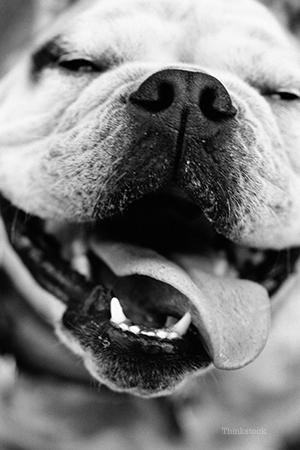
Dr. Ruth MacPete dishes on pet dental health. Read on to learn more about dental disease and how to keep your pet's ivories healthy and pearly white. For more from Dr. MacPete, find her on Facebook or at www.drruthpetvet.com!
Can you imagine what your teeth would look like if you never brushed them? Not pretty that’s for sure! So what about your pets’ teeth? Like us, pets need routine dental care. According to the American Veterinary Dental Society (AVDS), dental disease is the number one health issue affecting 80% of dogs and 70% of cats over the age of three. Not too surprising considering that most people don’t brush their pet’s teeth (and we know their pets aren’t doing it either). So why should you care? Poor oral hygeine doesn’t just cause bad breath, it can lead to tooth loss, painful abscesses, difficulty eating, and other serious health problems.
Dental disease in pets
So how does dental disease occur in pets? The combination of food, saliva, and bacteria leads to plaque formation. If this isn’t removed by brushing, it mineralizes and becomes tartar. Tartar accumulation promotes bacterial infections below the gumline, which result in gum recession and destruction of the tooth’s support structures. Without treatment, tooth loss and pain occur. Bacteria from a tooth infection can also enter the blood stream and spread to distant organs, like the kidney, liver and heart.
What if your pet has dental disease?
A complete dental cleaning is required if your pet already has dental disease. This involves an evaluation of the oral cavity and cleaning not only the surface of the teeth, but underneath the gumline where the majority of bacteria and tartar are found. After the teeth are cleaned, they are polished to smooth the rough surface created by the cleaning. Without polishing, these irregular surfaces allow bacteria and plaque to adhere more easily and accelerate the recurrence of dental disease. Next, an antibacterial solution is flushed below the gumline to remove any debris that collected after the scaling and polishing. Lastly the entire mouth is checked again and dental x-rays may be used to assess the extent of the dental disease and the need for tooth extractions or additional work. Even though most people can tolerate and sit through a thorough dental cleaning, pets can’t. The only way to perform a complete dental cleaning in pets is by using general anesthesia.
What about a non-anesthetic dental?
For many pet parents, the thought of placing their beloved pets under general anesthesia is scarier than the actual cleaning. So what about a non-anesthetic dental cleaning? It is important to know that it is currently illegal for anyone other than a veterinarian or a supervised and trained veterinary technician to perform a dental cleaning. Even when done by a trained professional, there are risks with non-anesthetic dentals. Animals with dental disease often have painful mouths. Without anesthesia, an animal may experience pain and move during the cleaning. This can be dangerous since many of the instruments used are quite sharp and can hurt the animal if it jerks during the procedure. However, the biggest issue with non-anesthetic dental cleanings is that the cleanings are superificial and do not address tartar under the gumline where the majority of dental disease resides. For these reasons, both the American Veterinary Dental College (AVDC) and the American Veterinary Dental Society (AVDS) do not recommend non-anesthetic dental cleanings.
What should be done before a cleaning?
So how can you make the anesthetic dental safer? Pre-anesthetic bloodwork and chest x-rays are used to screen for underlying medical issues. Although anesthesia can never be risk free, the use of modern gas anesthetics such as sevoflurane and isoflurane, sophisticated monitoring equipment, as well as intravenous catheters and IV fluids have greatly improved the safety of general anesthesia. Your veterinarian will need to look at your pet’s individual risks versus the benefits of dental care and advise you appropriately.
How do you keep your pet’s teeth clean?
Once your pet’s teeth are clean, routine dental care will maintain oral health and minimize the need for professional dental cleanings. Pets should IDEALLY have their teeth brushed daily using pet-safe toothpaste. I say IDEALLY because for most of us this isn’t possible, so do the best you can. Brush your pet’s teeth as often as you can and try to do it at least once a week if daily isn’t possible. While nothing beats regular brushing, oral rinses, dental diets and dental treats can help reduce the bacteria and plaque that lead to tartar formation. No matter what you choose, be consistent and see your veterinarian regularly for check ups. Remember early diagnosis and treatment are the best defense against serious dental disease.
If you have any questions or concerns, you should always visit or call your veterinarian – they are your best resource to ensure the health and well-being of your pets.
Also check out,
